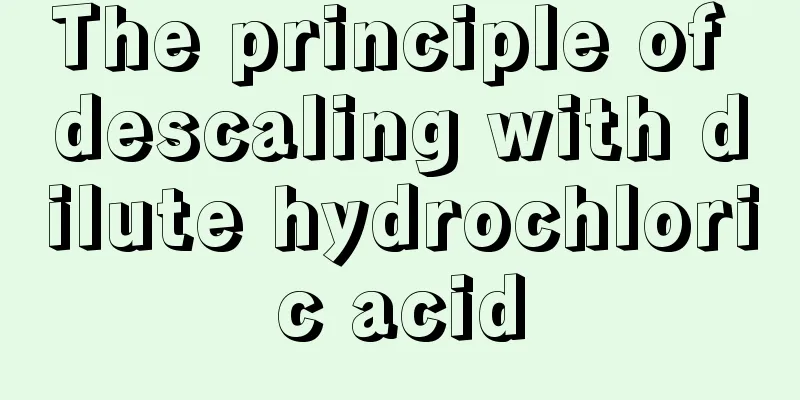The principle of descaling with dilute hydrochloric acid

|
In our daily life, there will be some scale in kettles and water pipes. These are caused by the rust in the water. When this happens, we need to solve it in time, because if it is not cleared for a long time, it will become more and more difficult to remove in the future. Today we will introduce to you the principle of descaling with dilute hydrochloric acid. Let’s take a look together below. Water containing minerals such as calcium (Ca) and magnesium (Mg) salts is called "hard water". River water, lake water, well water and spring water are all hard water. Tap water is river water, lake water or well water that has been sedimented, silt removed, and disinfected and sterilized. It is also hard water. The water from fresh rain or snow does not contain minerals and is “soft water”. After the water boils, part of the water evaporates, and the calcium sulfate (CaSO4, gypsum is calcium sulfate containing water of crystallization) that is originally insoluble precipitates. The originally dissolved calcium bicarbonate (Ca(HCO3)2) and magnesium bicarbonate (Mg(HCO3)2) decompose in boiling water, releasing carbon dioxide (CO2), and turning into insoluble calcium carbonate (CaCO3) and magnesium hydroxide (Mg(OH)2) which also precipitate. This is where scale comes from. When washing clothes with hard water, the calcium and magnesium ions in the water combine with soap to form flocculent precipitates of fatty acid calcium and fatty acid magnesium. This is the origin of "tofu dregs". Washing clothes in hard water wastes soap. Descaling in chemistry Scale ingredients: calcium carbonate (CaCO3), magnesium hydroxide (Mg(OH)2), magnesium carbonate (MgCO3), calcium sulfate (CaSO4), barium sulfate (BaSO4), silicon dioxide (SiO2), iron (Fe2O3 & Fe3O4) Cause of scale: Ca(HCO3)2 and Mg(HCO3)2 decompose in boiling water to release CO2. Descaling chemicals: Dilute hydrochloric acid (HCl) is commonly used, and sometimes vinegar can be used. Principle: Hydrochloric acid reacts with insoluble CaCO3 and Mg(OH)2 to form soluble salts. 2HCl+CaCO3=CaCl2+H2O+CO2↑(same chemical equation as the one used to make CO2 in the laboratory) 2HCl+Mg(OH)2=MgCl2+2H2O Note: Do not soak in acid for too long, otherwise it will react with the metal material of the kettle and damage the kettle. After descaling, rinse with water immediately and wipe with a dry cloth. The above is the principle of descaling with dilute hydrochloric acid introduced to us by professionals. If there is scale in household appliances at home, we can refer to the descaling method mentioned above, so that we can easily remove the scale without having to worry about it. I hope the above content can help everyone. |
<<: What is the significance of central venous pressure
>>: What are the methods for removing scale
Recommend
Bloody mucus in stool_Bloody mucus in stool
Feces is a kind of waste produced by everyone'...
How is radiofrequency ablation for liver cancer? A brief analysis of the effect of radiofrequency ablation for liver cancer
Liver cancer has a high incidence rate and is ver...
What are the symptoms of advanced lung cancer patients? Several clinical manifestations of advanced lung cancer
The symptoms of lung cancer vary at different sta...
What are the recipes to improve immunity
In different seasons, especially in winter, our b...
Laryngeal cancer prefers smokers
Mr. Li, who is over 60 years old, is a retired fa...
There is a hard lump on the top of my head
The hard bump on the top of the head may be a lip...
Symptoms of Chlamydia
Chlamydia is a common pathogen in people's li...
6 early symptoms of bladder cancer
The early symptoms of bladder cancer need to be p...
What are the benefits of drinking Moutai
Moutai can be said to be a relatively famous type...
How much does thyroid cancer surgery cost
There are many types of cancer nowadays, includin...
What is an easy way to cut mango?
Mango is a tropical fruit that is rich in various...
8 types of foods that women are prone to endometrial cancer. Foods to prevent endometrial cancer
No matter what kind of cancer it is, any disease ...
Is grape seed an antioxidant?
Nowadays, many people eat some grape enzymes, bec...
Correct treatment of skin cancer can effectively control the disease
Due to environmental factors or eating habits, pe...
How to distinguish the early and late symptoms of bladder cancer?
Bladder cancer is a common urinary system cancer....









